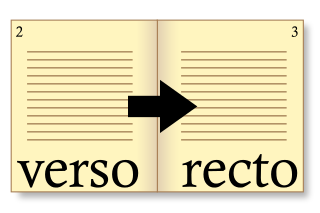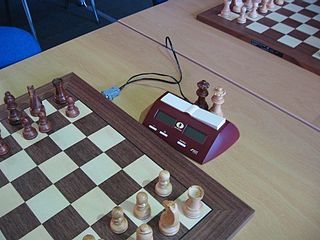
The pawn is the most numerous and weakest piece in the game of chess. It may move one square directly forward, it may move two squares directly forward on its first move, and it may capture one square diagonally forward. Each player begins a game with eight pawns, one on each square of their second rank. The white pawns start on a2 through h2; the black pawns start on a7 through h7.
The endgame is the final stage of a chess game which occurs after the middlegame. It begins when few pieces are left on the board.
This glossary of chess explains commonly used terms in chess, in alphabetical order. Some of these terms have their own pages, like fork and pin. For a list of unorthodox chess pieces, see Fairy chess piece; for a list of terms specific to chess problems, see Glossary of chess problems; for a list of named opening lines, see List of chess openings; for a list of chess-related games, see List of chess variants; for a list of terms general to board games, see Glossary of board games.

Parchís is a Spanish board game of the original from the Cross and Circle family. It is an adaptation of the Indian game Pachisi. Parchís was a very popular game in Spain at one point as well as in Europe and north Morocco - specifically Tangiers and Tetouan, and it is still popular especially among adults and seniors. Since it uses dice, Parchís is not usually regarded as an abstract strategy game like checkers or chess. It does not depend entirely on luck either, since the four pawns under a player's command demand some sort of strategy.

Sorry! is a board game that is based, like the older game Ludo, on the ancient Indian cross and circle game Pachisi. Players move their three or four pieces around the board, attempting to get all of their pieces "home" before any other player. Originally manufactured by W.H. Storey & Co in England and now by Hasbro, Sorry! is marketed for two to four players, ages 6 and up. The game title comes from the many ways in which a player can negate the progress of another, while issuing an apologetic "Sorry!"

Quoridor is a two- or four-player intuitive strategy game designed by Mirko Marchesi and published by Gigamic Games. Quoridor received the Mensa Mind Game award in 1997 and the Game Of The Year in the United States, France, Canada and Belgium.

The obverse and reverse are the two flat faces of coins and some other two-sided objects, including paper money, flags, seals, medals, drawings, old master prints and other works of art, and printed fabrics. In this usage, obverse means the front face of the object and reverse means the back face. The obverse of a coin is commonly called heads, because it often depicts the head of a prominent person, and the reverse tails.

Recto is the "right" or "front" side and verso is the "left" or "back" side when text is written or printed on a leaf of paper in a bound item such as a codex, book, broadsheet, or pamphlet.

In chess, promotion is the replacement of a pawn with a new piece when the pawn is moved to its last rank. The player replaces the pawn immediately with a queen, rook, bishop, or knight of the same color. The new piece does not have to be a previously captured piece. Promotion is mandatory when moving to the last rank; the pawn cannot remain as a pawn.

The Tarrasch rule is a general principle that applies in the majority of chess middlegames and endgames. Siegbert Tarrasch (1862–1934) stated the "rule" that rooks should be placed behind passed pawns – either the player's or the opponent's. The idea behind the guideline is that (1) if a player's rook is behind their own passed pawn, the rook protects it as it advances, and (2) if it is behind an opponent's passed pawn, the pawn cannot advance unless it is protected along its way.

Chu shogi is a strategy board game native to Japan. It is similar to modern shogi in its rules and gameplay. Its name means "mid-sized shogi", from a time when there were three sizes of shogi variants that were regularly being played. Chu shogi seems to have been developed in the early 14th century as a derivative of dai shogi. There are earlier references, but it is not clear that they refer to the game as we now know it.
The chess endgame with a king and a pawn versus a king is one of the most important and fundamental endgames, other than the basic checkmates. It is an important endgame for chess players to master, since most other endgames have the potential of reducing to this type of endgame via exchanges of pieces. Players need to be able to determine quickly whether a given position is a win or a draw, and to know the technique for playing it. The crux of this endgame is whether or not the pawn can be promoted, so checkmate can be forced.
Yari shogi is a modern variant of shogi ; however, it is not Japanese. It was invented in 1981 by Christian Freeling of the Netherlands. This game accentuates shogi’s intrinsically forward range of direction by giving most of the pieces the ability to move any number of free squares orthogonally forward like a shogi lance. The opposite is true of promoted pieces which can move backward with the same power.
Judkins shogi is a modern variant of shogi, however it is not Japanese. Credit for its invention has been given to Paul Judkins of Norwich, UK, prior to April 1998.
Heian shōgi is a predecessor of modern shogi. Some form of the game of Chaturanga, the ancestor of both chess and shogi, reached Japan by the 9th century, if not earlier, but the earliest surviving Japanese description of the rules dates from the early 12th century. Unfortunately, this description does not give enough information to actually play the game, but this has not stopped people from attempting to reconstruct this early form of shogi.
Shō shōgi is a 16th-century form of shogi, and the immediate predecessor of the modern game. It was played on a 9×9 board with the same setup as in modern shogi, except that an extra piece stood in front of the king: a 'drunk elephant' that promoted into a prince, which is effectively a second king. While 9×9 may not seem 'small', it was smaller than the other shogi variants prevalent at the time, which were the 12×12 chu shogi and 15×15 dai shogi. According to the Sho Shōgi Zushiki, the drunk elephant was eliminated by the Emperor Go-Nara, and it is assumed that the drop rule was introduced at about the same time, giving rise to shogi as we know it today.
Wa shogi is a large board variant of shogi in which all of the pieces are named for animals. It is played either with or without drops.
The rook and pawn versus rook endgame is a fundamentally important, widely studied chess endgame. Precise play is usually required in these positions. With optimal play, some complicated wins require sixty moves to either checkmate, capture the defending rook, or successfully promote the pawn. In some cases, thirty-five moves are required to advance the pawn once.

Circular chess is a chess variant played using the standard set of pieces on a circular board consisting of four rings, each of sixteen squares. This is topologically equivalent to playing on the curved surface of a cylinder.
The opposite-colored bishops endgame is a chess endgame in which each side has a single bishop and those bishops operate on opposite-colored squares. Without other pieces besides pawns and the kings, these endings are widely known for their tendency to result in a draw. These are the most difficult endings in which to convert a small material advantage to a win. With additional pieces, the stronger side has more chances to win, but still not as many as when bishops are on the same color.










